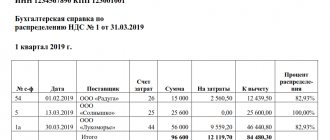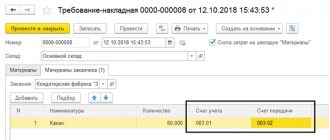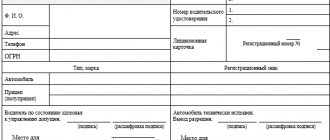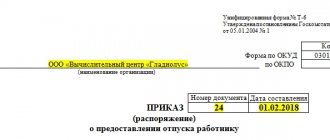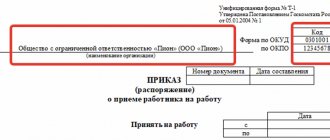Consignment note (Bill of Lading) is a document that is used to record inventory items when they are moved by vehicles. The TTN is usually drawn up by the sender of the cargo, but by agreement of the parties it can also be issued by the carrier. The consignment note is the basis for the decommissioning of cargo from the sender and its receipt at the recipient's warehouse.
The specification form is drawn up for each consignment of cargo transported by one vehicle. That is, there must be as many documents as there are vehicles involved in cargo transportation. Each TTN is issued in 3 copies: for the sender, the carrier and the recipient of the cargo.
How is it different from transport
Registration of TTN and TN is regulated by different legislative acts.
What else is the difference?
- In document form
. TN includes more sections than in TTN. The TTN has only 2 sections (commodity and transport), while the TN has as many as 17. - In number of copies
. TN is written out in triplicate, and TTN - in four. - In the details
. The TTN additionally indicates the code of the cargo, its price and quantity, and also contains fields for the signature of persons authorized to release the cargo. But the TN provides lines for entering information about the desired conditions of transportation (mode, transport features, etc.), and there is also a line in which you can enter information about forwarding if necessary.
Note!
According to RF Regulation No. 272 dated April 15, 2011, when issuing a TN in the case of road transport, the TN may not be issued. At the same time, when filling out the TTN, the issuance of the TTN is still mandatory, i.e. the rule works unilaterally.
What is it for?
TTN is one of the primary documents for accounting of transactions occurring at the enterprise. The design of the SP-31 form records:
- road transportation of material assets from the seller to the buyer, as well as the participation of a third party in them - the carrier company:
- The CTN includes confirmation of the conditions of cargo transportation, the cost of transportation;
- The main difference of the SP-31 form is the inclusion of information about the quality of transported agricultural products: name, class, presence of dirt and impurities, etc.
Find out why you need invoices and how to fill them out correctly.
By what standard is it compiled?
Today, the SP-31 form is not mandatory for use; its content is advisory in nature. An enterprise can develop its own form for such a document. It is important that the form includes all the necessary details in accordance with Article 9 of Federal Law No. 402-FZ of December 6, 2011.
The form also needs to reflect the industry specifics of shipment and receipt of grain products.
The SP-31 form includes the corresponding columns, so most enterprises use it, including additional information at their discretion.
Our experts have prepared useful information for you not only about filling out and using the TTN in the SP-31 form. You will learn about working with other waybills from the following publications:
- Why do we need transport and waybills and invoices, and how do these documents differ?
- Features of drawing up and filling out the TTN when picking up goods by the buyer.
- Features of working with TTN in EGAIS: how to find it and check it, how to correctly confirm the invoice?
- In what cases is an international CMR consignment note required and how to issue it?
- Special types of consignment note: for raw materials SP-33, for animals SP-32 and others.
Can other forms of TTN be used?
The form of the accounting document can be any, approved by an internal order of the legal entity.
At the same time, it will not be possible to use the unified form 1-T, since according to Resolution of the State Statistics Committee of the Russian Federation dated September 29, 1997 N 68 in the primary accounting document for the transportation of agricultural products, incl. grain, the document includes a procurement point containing information about the test weight and quality of the product.
Decor
Let's take a closer look at the features of filling out the form when transporting grain from the seller to the buyer.
Who fills out the document?
The responsibility for drawing up a consignment note rests with the supplier of agricultural products, i.e. to the selling organization. This rule also applies when the buyer hires a freight carrier himself.
Upon acceptance, a quality test is carried out, grain is weighed, based on the results of which information is entered into the TTN about how much grain is accepted and whether it corresponds to the declared quality. The data is entered by the recipient.
We talk about how and who fills out the consignment note in various situations in this material.
How many copies should there be?
The supplier creates 4 copies of SP-31:
- one form remains with the supplier;
- three forms are attached to the waybill and handed to the driver of the vehicle.
The driver provides documents to the person responsible for receiving grain at the unloading point. The forms are signed by the recipient of the cargo, one of them remains at the destination, and two are returned to the supplier.
Filling procedure
How to fill out the form:
- The TTN number must be entered in accordance with the supplier’s internal accounting documents.
- The date of preparation of the invoice is indicated.
- In the “Organization” column the name of the transport company performing the transportation is indicated.
- In the column “Organization that owns the vehicle,” the carrier company that owns the vehicle and its details must be indicated.
- The “Driver” column contains information about the vehicle driver.
- “Customer/payer” – the customer is the enterprise that has entered into a transportation agreement with the transport company.
- In the line “Consignor” the details of the seller of agricultural products are indicated.
- The line “Loading point” contains information about the place of grain shipment; the details of the workshop and team that carried out the shipment are also indicated.
- The consignee is the buyer or another organization carrying out acceptance on the basis of an agreement with the buyer; his details must be indicated in the column.
- “Unloading point” is the destination to which the cargo is sent.
- Next, fill in information about the cargo (procurement point):
- name of product (type of grain crop);
- variety, class, weediness, humidity (according to the results of the examination);
- at the place of departure, fill in the “Sent” column indicating the price and units of measurement;
- At the place of receipt of the goods, the “Accepted” column is filled in.
- The total amount is calculated and entered in the “Amount to be paid” line.
- The items “Vacation allowed” and “Passed in” are filled in at the point of shipment.
- The “Accepted” item is filled in by the person responsible for acceptance at the destination.
Signing and stamping
SP-31 is signed by the enterprises participating in the supply agreement. At the end of the document, when the grain is released, the employees of the selling organization responsible for the shipment sign.
When delivering the grain, the forwarding driver or other representative of the carrier signs, and the buyer’s representative also signs for acceptance of the goods.
All signatures must be deciphered, indicating full names and positions. Stamps are placed on the signatures of authorized persons.
We have provided a detailed procedure for preparing a consignment note, the rules for signing and stamping it in our article. Competently filling out all points of the form can guarantee that there are no problems when transporting grain, as well as when making payments to pay for the carrier’s services.
If you find an error, please select a piece of text and press Ctrl+Enter.
Accountant's Directory
Answer: From the norms of the Civil Code of the Russian Federation, as well as by analogy with the transport section of the consignment note in form N 1-T (approved by Resolution of the State Statistics Committee of Russia dated November 28, 1997 N 78) in the line “Customer/Payer” of the consignment note for Form N SP-31 (approved by Resolution of the State Statistics Committee of Russia dated September 29, 1997 N 68) must indicate the organization that enters into a transportation agreement with the transport organization, in this case the seller. However, due to the fact that there are no official explanations for filling out this form, the organization has the right to indicate in form N SP-31 both the seller (in the line “Customer/Payer”) and the buyer (in an additional column added independently).
Rationale: Resolution of the State Statistics Committee of Russia N 68 “On approval of unified forms of primary accounting documentation for accounting of agricultural products and raw materials” approved the form of the consignment note for the transportation of grain N SP-31.
This form is intended for recording business transactions for the transportation of grain and products of its processing (clause 67 of the Recommendations for filling out industry forms of accounting documents for grain and products of its processing, approved by Order of the Russian State Grain Inspection dated 04.04.2003 N 20, hereinafter referred to as Recommendations for filling out N 20; p 2, paragraph 4, paragraph 15 of Methodological recommendations for accounting of inventories in agricultural organizations, approved by Order of the Ministry of Agriculture of Russia dated January 31, 2003 N 26, hereinafter referred to as Methodological recommendations N 26).
At the same time, the rules for filling out form N SP-31 apply to legal entities engaged in the procurement, storage, processing and sale of grain (clause 1 of Recommendations for filling out N 20). The consignment note in form N SP-31 is drawn up in four copies, one of which remains with the compiler, and the other three are issued to the driver of the vehicle. When using transport from another transport organization, two copies of the invoice are transferred to the transport organization, one of which is then attached to the invoice for the transportation of goods (clause 68 of Recommendations for filling out No. 20). This form is necessary for carrying out quantitative and qualitative accounting of grain by organizations involved in the sale of these products (clause 3 of the Procedure for accounting for grain and products of its processing, approved by Order of the Russian State Grain Inspection dated 04/08/2002 N 29).
What it is?
Resolution of the State Statistics Committee of Russia N 68 “On approval of unified forms of primary accounting documentation for accounting of agricultural products and raw materials” approved the form of the consignment note for the transportation of grain SP-31.
The obligation to use the form rests with all legal entities engaged in the storage, sale and processing of grain products.
Ttn sp 31 sample filling
Thus, the consignment note in form N SP-31 is drawn up by the sender (supplier), regardless of who enters into a transportation agreement with a motor transport organization - the supplier or the buyer.
Recommendations for filling out No. 20 do not provide line-by-line explanations for filling out the form, including the line “Customer/Payer”.
At the same time, the consignment note in form N SP-31, in addition to the specified line, also contains the lines: “Organization”, “Organization - owner of the vehicle”, “Consignor”, “Consignee”, which in practice do not cause difficulties in filling out. According to Art. 506 of the Civil Code of the Russian Federation, under a supply agreement, the seller acts as a supplier and undertakes to transfer goods to the buyer in accordance with the terms of the agreement. Thus, the supply agreement identifies the parties to the contract - the supplier and the buyer.
Under a contract for the carriage of goods, the parties to the contract are identified, called the “Carrier” (cargo carrier) and the “Buyer” (consignee) (Clause 1 of Article 785 of the Civil Code of the Russian Federation, Article 2 of the Federal Law of November 8, 2007 N 259-FZ “Charter of Motor Transport and urban ground electric transport", Article 2 of the Federal Law of January 10, 2003 N 18-FZ "Charter of Railway Transport of the Russian Federation").
According to Art. 702, paragraph 1, art. 779 of the Civil Code of the Russian Federation, such a party as the customer is present when concluding contracts for construction or provision of services (Article 702, paragraph 1 of Article 779 of the Civil Code of the Russian Federation). As we can see, from the norms of the Civil Code of the Russian Federation it follows that there can be a “customer of transportation”, but not a “customer of grain”. Therefore, in the line “Customer/Payer” of form N SP-31, the customer of the transportation service must be indicated (in the situation described in the question, this is the seller organization that enters into an agreement with the transport organization).
In addition, the purpose of the consignment note in form N SP-31 is similar to the consignment note in form N 1-T, which is filled out by shippers during normal transportation (clause 71 of Methodological Recommendations No. 26, Letter of the Federal Tax Service of Russia dated July 22, 2011 N ED-4-3/ [email protected] ).
According to the Instructions for the use and completion of forms (approved by Resolution of the State Statistics Committee of Russia dated November 28, 1997 N 78 “On approval of unified forms of primary accounting documentation for recording the work of construction machines and mechanisms, work in road transport”), the transport section of the invoice according to form N 1-T serves to determine the relationship between the transport organization and the organization that customer of the vehicle.
In this case, the consignment note in form N 1-T contains the line “Payer” in the product section, as well as the line “Customer (payer)” in the transport section. According to the explanations of the Federal Tax Service of Russia for the city of Moscow, in the line “Customer (payer)” of the transport section it is necessary to indicate the organization that orders and pays for delivery, and in the line “Payer” of the goods section - the purchasing organization (Letter dated July 25, 2008 N 20-12 /070321).
Since the consignment note in Form N SP-31 contains only one line “Customer/Payer”, the organization has the right to use the above explanations and assume that the line “Customer (payer)” of Form N SP-31 indicates the organization that is the customer of transport services . In the situation described in the question, this is the seller organization that enters into a transport contract and pays for the services of the transport organization.
However, it should be noted that there are no official explanations for filling out form N SP-31. When filled out in accordance with the above procedure, the purchasing organization will appear in this document only as a consignee and only on the condition that it acts as a consignee. In other cases, the grain buyer will not be indicated on this form at all. If an organization wants to make the form more convenient for itself and other users, it has the right to independently add the necessary lines to it (clause 5 of Recommendations for filling out No. 20).
Thus, since there are no official explanations for filling out this form, the organization has the right to indicate in form N SP-31 both the seller (in the line “Customer/Payer”) and the buyer (in an additional column added independently).
E. A. Fedortsova
Publishing house "Glavnaya Kniga"
——————————————————————
>Sample of filling TTN grain
Filling out the consignment note sp31 for the transportation of grain
For example, if there are a lot of them.
In this case, it is necessary to draw up a consignment note in form TORG-12 and make a link to it from the commodity section of the TTN form 1 T. After which the completed form TORG-12 becomes an integral part of the consignment note form T 1. The number must be indicated on its first page and date of TTN form 1 T.
In TTN T 1, the transport section is intended to reflect information about road transportation, including detailed information about the cargo and the carrier.
In the “Customer” field of the transport section of TTN T 1, you must enter data about the customer of the road transportation.
It can be any party to the transportation – the shipper or the consignee. According to the TTN, the sample filling requires signing by three parties to the road transport: the consignor, the carrier and the consignee.
Certain signatures are required from each participant in road transportation.
- On the part of the shipper, the document is signed by:
- the responsible person who authorized the shipment of goods or other goods and materials;
- Chief Accountant;
- the employee who carried out the shipment.
- On the part of the motor carrier - the driver or other person responsible for the transported property.
- On the part of the consignee - the responsible person who accepted the cargo from the road carrier.
For the TTN, see the sample filling in the window, the document can be downloaded: Depending on the nature of the cargo, the document must be drawn up in three or four copies.
- If the cargo is of a non-commercial nature.
In this case, it is enough to fill out the TTN T 1 on three forms - one for each party to the road transportation.
- If the cargo is of a commercial nature.
In this case, TTN T 1 must be drawn up in four copies - for the sender (first copy), for the recipient (second copy), and also two copies for the road carrier.
A sample TTN form 1 T according to the standard form from Decree No. 78 dated November 28, 1997 can sometimes not be completed.
There are two reasons for this.
Consignment note. Form SP-31
The consignment note (grain) in form N SP-31 is used to record operations for sending and receiving grain products to elevators, grain collection centers and other points for receiving grain products.
The consignment note is an accompanying document for the delivery of grain products to receiving points. It is issued in 4 copies: one remains with the warehouse manager (current), and three are given to the driver of the car. At the procurement point, the actual accepted test weight and quality of the product (grade, contamination, humidity, etc.), price and amount are entered in the invoice. One copy of the completed delivery note remains at the grain collection point, and two signed copies are returned to the driver. When returning to the organization, the driver gives the warehouse manager one copy of the invoice to confirm the delivery of the products to the procurement point, and attaches the other as a report on the work performed to the truck waybill (tractor waybill). When using contracted transport, two copies of the invoice are handed over to the transport organization, one of which is then attached to the invoice for the transportation of goods.
The supply manager registers all invoices for the shipment of products in the Register of Documents for the Disposal of Products (Form N SP-3).
Consignment note. Form SP-31 is a document that is used when it is necessary to keep records of operations for sending and receiving grain products to grain receiving, elevator, and other points for receiving such products.
The invoice is drawn up in 4 copies.
Results
Consignment note SP-31 is not required for use.
But in practice, as a rule, this is what is used, because it contains all the fields for accounting for the transportation of grain products, registering leave and confirming the delivery of grain products to elevators, grain collection points and other reception points. You can find more complete information on the topic in ConsultantPlus. Free trial access to the system for 2 days.
Service Temporarily Unavailable
The first copy of the document remains in the hands of the warehouse manager, and the remaining three documents are handed over to the driver of the vehicle through which the grain is transported. Thus, the driver is obliged to further hand over these documents: one of them is sent to the grain collection point, and the other two documents are signed there by an authorized person and then returned to the hands of the driver of the vehicle. After the vehicle is returned back to the enterprise, one of the signed documents is given to the warehouse manager, and the other is attached to the truck’s Waybill.
This document has a unified form, which was provided for by the legislation of the Russian Federation. Form SP-31 is an accompanying document in the process of delivering grain products to the appropriate receiving points.
Posted on November 30, 2017by. This entry was posted in Category name. Bookmark the permalink.
The consignment note is a mandatory document to accompany the cargo during its movement; you can download the consignment note in EXCEL and WORD formats on this page.
General concepts and types of consignment note
A waybill, abbreviated as TTN, is a document confirming the movement of goods from one place to another. Based on this invoice, the goods are written off from the consignor, and in turn, the consignee receives them. These types of documents usually accompany the cargo when moving.
TTN is usually written out in 3 or 4 copies:
Remains with the sender to confirm the write-off of the goods. Transferred to the consignee and is the basis for capitalization. Intended for the cargo carrier and is the basis for payment for transportation. If necessary, remains with the carrier driver and is the basis for calculating wages.
Rules for registration and procedure for working with the form
This document refers to primary documentation, so when filling it out, you should adhere to certain standards. In particular, you must not leave cells empty (where dashes should be placed), allow inaccuracies and errors, or enter incorrect information into the form.
Additional documents may be attached to Form 1-T:
- certificates,
- passports,
- certificates,
- contracts, etc.
All of them must be indicated in the “Attachment” line of the delivery note.
The document is printed in four copies , one of which remains with the sender of the goods, the other three are handed over to the driver who will deliver the goods.
All documents must be certified with the required signatures. Then the driver must hand over the second copy to the consignee, and the third and fourth copies must be handed over to the management of the transport company (they must have the signatures of both the sender and the recipient of the goods). After this, the third copy with the issued invoice for payment for transportation services is sent to the customer (i.e., the company that entered into an agreement for the delivery of the goods), and the fourth remains with the carrier and becomes part of its accounting records.
Other types of consignment note
There is also a consignment note SP-31; you can also download the form in EXCEL and PDF formats in this article. The consignment note is intended for the transportation of grain and other agricultural products. The form was approved back in 1997, but since 2013, mandatory use has been abolished. But this invoice remains useful to this day for accounting and transporting goods.
>Download the waybill
Click “Like” if the article was useful or share on social networks
Sample documents
Where to find form SP-31
The SP-31 form is very similar to the regular TTN form, but still has its own features. Therefore, when transporting grain products, it is recommended to use only this form.
The current form SP-31 can be downloaded from our website:
For more information about the types of documents used to confirm costs for the delivery of goods other than grain, read the material “Confirmation of transport costs - with what documents?”
Consignment note (grain). Standard interindustry form N SP-31
Standard interindustry form N SP-31
Approved by Order of the Russian State Grain Inspectorate dated 04/08/2002 N 29
COMMODITY - TRANSPORT CONTRACT (grain) N __
“__”_____________ 19__ ————¬ ¦ Codes ¦ +———-+ OKUD Form ¦ 0325031 ¦ +—T—T—+ Date of compilation ¦ ¦ ¦ ¦ +—+—+—+Organization _____________________________________ by OKPO ¦ ¦ +———-+Car brand _________________________________________ ¦ ¦State license plate ______ to the waybill N ¦ ¦ L————Organization - owner of the vehicle _________________________________ name, address, telephone number
Driver ___________________________________ _______________________________ last name, first name, patronymic type of transportation Customer (payer) __________________________________________________________ name, address, telephone number
Shipper _____________________________________________________ name, address, phone number —TT-¬Point Department (workshop), ¦ ¦ ¦ ¦loading _____________________________________ team, unit L-+-+— address
Consignee ______________________________________________________________ name, address, telephone number Unloading point __________________________________ Route N ¦ ¦ address +————+ Trailer: State ¦ ¦ license plate number _______________________ Garage number ¦ ¦ Information —————¬ —+——— —+ about cargo Account ¦ ¦ Account ¦ ¦ (debit) L————— (credit) L—————
Products ____________________________________________________________ name of grains and oilseeds, seeds, herbs
Variety, class ________________ Infestation _____% Humidity ____%
———T———T——T——T——————T——-T———-¦Operation¦Type ¦Quantity ¦Class¦ Weight, kg ¦ Price, ¦ Amount, ¦ ¦ ¦packing ¦quality¦cargo+——T—-T——+ rub. ¦ rub. kop.¦¦ ¦ ¦ ¦ ¦gross¦tara¦net¦ kop. ¦ ¦+———+———+——+——+——+—-+——+——-+———-+¦ ¦ 1 ¦ 2 ¦ 3 ¦ 4 ¦ 5 ¦ 6 ¦ 7 ¦ 8 ¦+———+———+——+—+——+—-+——+——-+———-+¦Sent- ¦ ¦ ¦ ¦ ¦ ¦ ¦ ¦ ¦¦sent ¦ ¦ ¦ ¦ ¦ ¦ ¦ ¦ ¦¦ +———+——+——+——+—-+——+——-+———-+¦Accepted ¦ ¦ ¦ x ¦ ¦ ¦ ¦ ¦ ¦L———+———+—T—+——+T——+-T—+—-T+——T+———-+ ¦For valuable ¦For sorts-¦For containers¦For dos- ¦Others ¦ Total for ¦ ¦ grades ¦ leveling and ¦ ¦ rate ¦ surcharges¦ payment ¦ ¦ ¦ packaging ¦ ¦ products-¦ ¦ ¦ ¦ ¦ ¦ ¦ ¦ ¦ ¦ +————-+———+—— -+——-+——-+————+ ¦ 9 ¦ 10 ¦ 11 ¦ 12 ¦ 13 ¦ 14 ¦ +————-+———+——-+——-+——- +————+Additional allowances ¦ ¦ ¦ ¦ ¦ ¦ ¦- rub. L————-+———+——-+——-+——-+————kop. ————-¬Amount for Invoice ¦ ¦payment _________________________________________ (debit) ¦ ¦ (in words) +————+ Invoice ¦ ¦ __________ rub. ________ kop.
(credit)¦ ¦ L————-
Vacation allowed _______________ ____________ _________________________ position signature transcript of signature
Products for transportation: number of pieces _____________ weight, net, kg in words
__________ in words
passed ____________ _____________ ____________________ position signature transcript of signature
accepted __________ _____________ ____________________ position signature transcript of signature
Appendix _________________________________________________ on _____ sheets of certificate, passport, certificates, etc.
Reverse side of form N SP-31
Products by weight, In the weight journal, quality and assortment are recorded under N ________________ accepted ___________ _________ ___________ Weigher _______ ____________ position signature transcript signature transcript signature signature
Method for determining weight gain: acceptance ___________________ delivery _____________________
Loading and unloading operations
———-T————T———T————————————-¬¦Operation ¦Executor¦Method ¦ Time, h, min. ¦¦ ¦(ATP, from- ¦ (manual, +————T————T————+¦ ¦ruler, ¦mechanical ¦arrival ¦departure ¦idle ¦¦ ¦recipient)¦checal) ¦ ¦ ¦ ¦+———+————+———+————+————+————+¦ 15 ¦ 16 ¦ 17 ¦ 18 ¦ 19 ¦ 20 ¦+———+ ————+———+————+————+————+¦Loading ¦ ¦ ¦ ¦ ¦ ¦¦ +————+———+————+—— ——+————+¦Unloading¦ ¦ ¦ ¦ ¦ ¦+———+————+-T——+-T———+————+————-¦Additional operations ¦Signature ¦+——T—————-+responsibility-¦ Transport services _______________¦time,¦ name, ¦venue ¦ ___________________________________¦ min. ¦ quantity ¦ persons ¦ Notes on drawn up acts ______+——+—————-+———+ ___________________________________¦ 21 ¦ 22 ¦ 23 ¦ ___________________________________+——+—————-+———+¦ ¦ ¦ ¦+——+—————-+———+¦ ¦ ¦ ¦L——+—————-+———
Other information (to be filled in by the organization that owns the vehicle)
——————————————T——T———————¬¦Transportation distance by groups of roads, km¦Code ¦ For transport ¦+——T—-T——— T———T————+ex- ¦ services ¦¦total¦in ¦I group¦II group¦III group ¦pedi-+———-T———+¦ ¦go- ¦ ¦ ¦ ¦tor ¦from the client ¦to the driver ¦¦ ¦like¦ ¦ ¦ ¦ ¦ ¦ ¦+——+—-+———+———+————+——+———-+———+¦ 24 ¦ 25 ¦ 26 ¦ 27 ¦ 28 ¦ 29 ¦ 30 ¦ 31 ¦+——+—-+———+———+————+——+———-+———+¦ ¦ ¦ ¦ ¦ ¦ ¦ ¦ ¦+——+—-+-T—-T-+——-T-+———-T+——+T———T+———+¦Adjustment ¦ ¦Calculation ¦ For tons ¦ ¦ ¦ ¦¦coefficient ¦ ¦cost- ¦ ¦ ¦ ¦ ¦+——T——+ ¦bridges ¦ ¦ ¦ ¦ ¦¦ras- ¦basis-¦ ¦ ¦ ¦ ¦ ¦ ¦¦priced ¦ ¦ ¦ ¦ ¦ ¦ ¦¦driver tariff ¦ ¦ +————+——-+———+———-+¦tel ¦ ¦ ¦ ¦ 35 ¦ 36 ¦ 37 ¦ 38 ¦+——+—— +—-+———+————+——-+———+———-+¦ 32 ¦ 33 ¦ 34 ¦Completed¦ ¦ ¦ ¦ ¦+——+——+—-+ + ————+——-+———+———-+¦ ¦ ¦ ¦Price,¦ ¦ ¦ ¦ ¦¦ ¦ ¦ ¦rub. cop.¦ ¦ ¦ ¦ ¦¦ ¦ ¦ ¦ +————+——-+———+———-+¦ ¦ ¦ ¦Payable,¦ ¦ ¦ ¦ ¦¦ ¦ ¦ ¦rub. cop.¦ ¦ ¦ ¦ ¦+——+-T—-+—-+———T+——T——+-T——+———+————¦Loaded- ¦Excessive ¦Others ¦ Discounts ¦Total¦ Taxation: ¦exactly -¦ simple ¦extra payment¦for juice-¦ ¦ ___________________¦unloading-+———T———+ ¦rotation¦ ¦ ___________________¦exact ¦loading¦unloading¦ ¦idle¦ ¦ ___________________¦ work,¦ ¦ ¦ ¦ ¦ ¦ Taxi driver _______¦т ¦ ¦ ¦ ¦ ¦ ¦ ___________________+——-+———+———+——-+——-+——+ signature¦ 39 ¦ 40 ¦ 41 ¦ 42 ¦ 43 ¦ 44 ¦+——-+———+———+——-+——-+——+ ___________________¦ ¦ ¦ ¦ ¦ ¦ ¦ transcript+——-+———+— ——+——-+——-+——+ signatures¦ ¦ ¦ ¦ ¦ ¦ ¦+——-+———+———+——-+——-+——+¦ ¦ ¦ ¦ ¦ ¦ ¦L——-+———+———+——-+——-+——
How to fill out the invoice correctly
“Consignment note (grain)” form No. SP-31 consists of two pages.
On the first page you need to indicate:
- invoice number;
- date of compilation;
- name of the organization, OKPO code;
- waybill number;
- make and state number of the vehicle;
- information about the owner of the car;
- FULL NAME. driver;
- type of transportation;
- data of the customer organization for road transportation;
- data of the shipping organization;
- loading point address;
- data of the consignee organization;
- address of the point where the unloading took place;
- state license plate of the trailer.
Next, in the TTN (grain) form SP-31, you must indicate the name of the product and its characteristics (variety, moisture content, etc.).
Below is a table in which you must indicate information about the commodity transaction:
- name of the operation (sent, received);
- type of packaging;
- quantity;
- cargo class;
- weight;
- product price, total cost;
- amount of allowances.
Below the table indicate the amount to be paid (in numbers and in words). The document must be signed by the person who authorized the release of agricultural products and the employee responsible for the shipment. This could be a storekeeper or another warehouse worker. In the “Attachments” line, you must indicate the details of documents confirming the quality of grain (certificates, certificates, etc.).
On the reverse side of the SP-31 (grain) form the following is indicated:
- position and full name the employee who accepted the product;
- position and full name weigher;
- a method for determining the mass of cargo upon acceptance and upon delivery.
Below is a table that displays information about loading and unloading operations. Here they indicate who and in what way loaded and unloaded the vehicle, the time of arrival, departure and downtime. If necessary, write down data on transport services, additional operations, and drawn up acts.
Below is another table that displays information about road transportation. It must be filled out by the carrier organization that owns the vehicle. Here you need to indicate the transportation distance by road group, forwarder code, cost of transport services, and tax information.
A correctly executed invoice is used in the accounting records of each of the transportation participants. A sample and form of TTN (grain) form SP-31 can be downloaded below.
Form of waybill for transportation of grain
When transporting agricultural products, it is recommended to use a special consignment note for grain. The form of this primary document is unified; it was approved by Resolution of the State Statistics Committee dated September 29, 1997 No. 68.
Until 2013, the use of the SP-31 consignment note was mandatory. However, after the adoption of the new accounting law, the need to use unified forms was abolished. You can develop such a form yourself. It is only important that it contains the required details for such a document (Article 9 of Law No. 402-FZ dated December 6, 2011).
But since the SP-31 consignment note already contains all these details, and in addition, it contains columns reflecting the specifics of grain acceptance, it continues to be actively used. Moreover, each user can add some of their own data to the form, for example, provide a place to display encrypted information or place their logo, etc.
Rules for using waybills SP-31
The consignment note form SP-31 is issued when transporting grain products to their acceptance points. These can be grain receiving enterprises, elevators, etc.
According to the rules, the invoice should be issued in 4 identical copies, with 1 remaining with the person responsible for loading the grain, and the remaining ones transferred to the driver of the vehicle.
At the grain procurement point, the following factual data is filled in the form:
Of the 3 invoices received at the grain point, one remains in place, and 2 are handed over to the driver.
When returning to the base, the driver attaches 1 of 2 completed copies of the waybill (Bill of Lading) to his waybill, and the other is given to the same person responsible for loading grain, who wrote out 4 copies of the BW when the vehicle left for the grain receiving enterprise. If hired vehicles were used, the driver gives 2 copies of the TTN to the accounting department, and subsequently one of the completed SP-31 forms is attached to the invoice for motor transport services and handed over to the customer.
The waybill form can be seen in our article “Truck waybill in accounting (form).”
